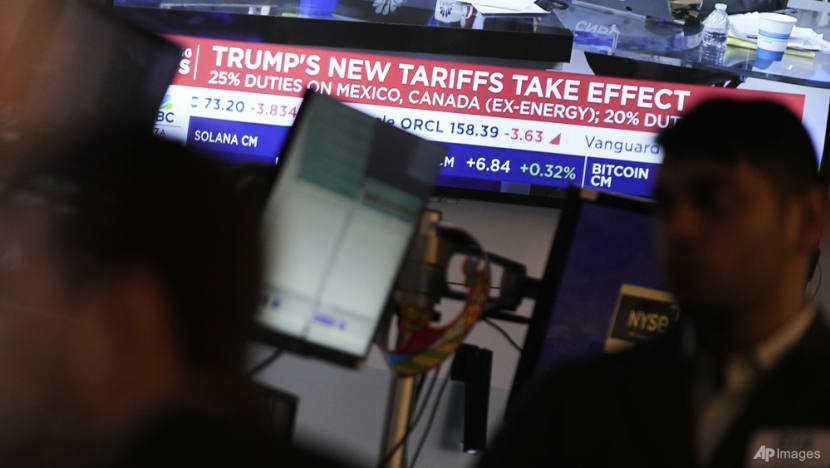Commentary: Is the bull market in ‘detox’ or melting down?
Self-reinforcing momentum carried US equities for two years. Now, inertia is pulling them in the wrong direction, says Jonathan Levin for Bloomberg Opinion.

MIAMI, Florida: A self-reinforcing momentum has carried the US stock market higher for more than two years. Since the bear-market low in October 2022, the S&P 500 Index has returned an extraordinary 67 per cent.
The more stocks went up, the more investors around the world believed that they would continue to go up. Unfortunately, that self-perpetuating inertia suddenly seems to be carrying us in the wrong direction.
Late last month, the S&P 500 plummeted through its 100-day moving average, a sign that the trend may be turning, and it’s recently been flirting with the first drop below the 200-day trendline since 2023. Bottom-up Wall Street analysts – who reinforced investors’ bullishness for most of the rally – have begun to very subtly drop their 12-month price targets.
Meanwhile, global equity markets, including in Europe and China, have suddenly captured some relative momentum of their own, suggesting that US stocks are no longer the only game in town.
GROWING RISKS
These developments are hard to ignore.
First, the macroeconomic backdrop has been shifting quickly under investors’ feet. While corporate earnings have remained relatively strong, President Donald Trump’s multi-front trade war is sowing widespread uncertainty that is weighing on business and consumer sentiment.
His Department of Government Efficiency has also been pushing for widespread cuts to government payrolls, which will likely start showing up in employment data in the weeks and months ahead.
And the lingering threat of inflation – potentially exacerbated by Trump’s tariffs – may restrict the Federal Reserve’s flexibility to cut policy rates to support the economy, including the flagging housing market.
Second, price-earnings valuations were already on the high side. At about 21 times, the S&P 500’s blended forward price-to-earnings ratio is still well above its old “normal” of around 17 times in the 2015 to 2019 period.
Fundamentals certainly played a role in the 2022 to 2025 bull market, and optimists have understandably pointed to soaring economic growth, earnings and a genuine revolution in generative artificial intelligence.
Even so, the lion’s share of equity returns have come from multiple expansion, which has become harder to justify as risks resurface, bond yields remain high and competing equity markets rediscover their mojos.
TEMPORARY STRUGGLES?
There’s a case to be made, of course, that the market’s struggles are temporary.
“The market and the economy have just become hooked” on public spending, Treasury Secretary Scott Bessent told CNBC on Friday (Mar 7). “There’s going to be a detox period.”
While Trump’s trade policies have unsettled markets, some commentators argue that they are trade-war theatre. The president, they assert, can revive markets in the back half of the year by turning investors’ focus to tax cuts and deregulation, campaign promises that Wall Street generally sees as pro-growth.
Equally, it’s hardly unusual for technology stocks, which have been on a tear, to take a breather – dragging the Nasdaq 100 close to a 10 per cent correction.
Maybe so, but there are plenty of risks. Politically, Trump promised during the campaign that he’d bring about a wave of reshoring, and it’s unclear that he’ll be willing to back down from tariffs entirely, particularly as it concerns China.
That would leave companies facing a costly and time-consuming process of reorienting supply chains to meet Trump’s standards.
At the same time, taxes and deregulation will require the hard work of political consensus-building.
Even with control of Congress, Republicans’ narrow House majority probably isn’t large enough to make the process easy. Trump will have to convince deficit hawks in his own party that they should look past the soaring national debt and grant Americans US$4.5 trillion in tax breaks over a decade.
Even if the politicians sign off, bond market vigilantes may decide that they have other plans.
FIGHTING INERTIA
Consumers could be one of the most important wild cards. The combination of volatile markets and higher prices from tariffs may cause US shoppers to retrench.
In fact, research from Fed economists shows that retail sales demand in recent years has been mostly fuelled by middle- and especially high-income households. The latter group’s spending has presumably been supported by the “wealth effect” from booming investments and home values.
Recent readings for retail sales and personal consumption expenditures hint that spending growth may already be stalling.
Inertia is a powerful force, and it’s far from clear that Trump will be able to halt a slump once it’s demonstrably underway, even if the policy backdrop improves.
For the past couple of years, soaring stock-market returns have made Americans feel richer and spend a bit more than they otherwise might have, which ultimately supported corporate earnings.
But inertia works on the way down as well. Steep market declines can make consumers and businesses more cautious, and layoffs that begin as a trickle can feed upon themselves.
Once a bull market is broken, it’s not particularly easy to put it back together again.

















